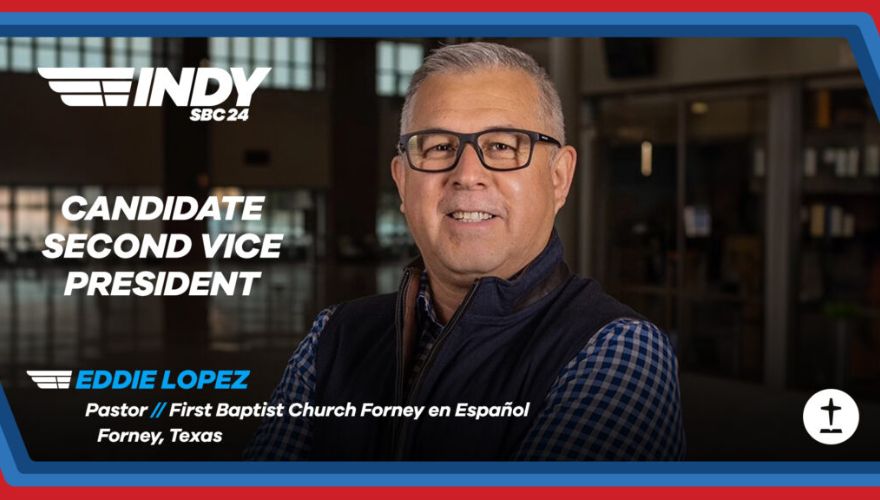
INDIANAPOLIS (BP) — Theological differences in convention authority and church authority were considered during the first of two 9Marks sessions June 10 at the Indianapolis Marriott Downtown. More than 1,400 people attended ahead of the Southern Baptist Convention’s (SBC) vote on the Law Amendment.
The amendment, which failed to achieve a second two-thirds vote June 12, sought to amend the SBC’s constitution to state that one way a church is considered to be in “friendly cooperation” is if it “affirms, appoints, or employs only men as any kind of pastor or elder as qualified by Scripture.”
The first session, “Convention Authority vs. Church Authority: What is the Difference?” featured a presentation from Jonathan Leeman, editorial director for 9Marks and author of “Authority: How Godly Rule Protects the Vulnerable, Strengthens Communities, and Promotes Human Flourishing.”
Also included was a panel discussion with Nate Akin, executive director of the Pillar Network and founder/director of Baptist21; Travis Kerns, associational mission strategist at Three Rivers Baptist Association in Taylors, S.C.; Greg Wills, director of research doctoral studies and professor of church history at Southern Baptist Theological Seminary; and Mark Dever, president of 9Marks and pastor of Capitol Hill Baptist Church in Washington, D.C.
Following a gospel hymn-sing, Leeman responded to two media messages: one by former Southwestern Baptist Theological Seminary (SWBTS) President Ken Hemphill and the other by Malcolm Yarnell, research professor of theology in the school of theology at Southwestern.
In his article, “On the Current Crisis in the Southern Baptist Convention,” on the website, The Baptist Review, Hemphill lamented that in recent years, it appears that the SBC is “slowly but surely embracing a top-down hierarchical model” and its “ecclesiology is moving away from our historic congregational model to more of a presbyterial or even episcopal model, perhaps something akin to what Southwestern Baptist theologian W.W. Barnes declaimed as ‘presbygationalism.’” The article references “telling a local church what titles are appropriate for anyone on their staff.”
A Nov. 20 tweet by Yarnell said, “If Southern Baptists make the final transition into treating the Baptist Faith and Message (BF&M) as necessary for all member churches, we will have taken a significant step into a constrictive Presbyterian view of confessions and a significant step away from historic Baptist freedoms.”
“Are Drs. Hemphill and Yarnell correct?” asked Leeman, an elder at Cheverly Baptist Church in Bladensburg, Md., who has been serving this past year on a group assigned by SBC President Bart Barber to explore what it means for a church to be in “friendly cooperation” with the SBC and that “closely identifies” with the convention’s statement of faith, the BF&M.
The 20-member cooperation study group, which was created in response to a motion at last year’s annual meeting in New Orleans, addressed the differences between a conventional model vs. a top-down denominational model, Leeman said. He explained the BF&M 2000’s Preamble affirms the 1963 committee who “rightly sought to identify and affirm ‘certain definite doctrines that Baptists believe, cherish, and with which they have been and are now closely identified.’”
Noting that the SBC is not the only group of churches who uses language like “closely identifies,” Leeman pointed to the Presbyterian Church of America (PCA), which ascribes to Westminster Standard’s “Directory for the Publick Worship of God.”
Like the BF&M, the directory is a guide and is not obligatory, Leeman said, explaining that ironically, the PCA is considering its own version of the Law Amendment regarding only qualified men preaching.
One may be tempted to sympathize with Hemphill and Yarnell, Leeman said, but he countered by explaining the differences between connectionism, where the Roman Catholics, the Anglican Church in North America and the PCA fall, and cooperation, where the SBC falls.
In connectionism, the denomination has authority to establish or dissolve a church, add or remove a pastor or members and change doctrine. And the more authority over constituting elements, the more they’re “one church,” Leeman said.
For example, “if a church persists in having a woman preach, connectional churches can dissolve the church and defrock the pastor,” Leeman said, noting how the authoritative denominations set the teaching and who the pastors are, among other controls, much in the way a centralized military command center exercises leadership over individual units under them.
Conversely, autonomous cooperating churches cooperate in areas such as evangelism, pastors’ conferences, seminaries and church planting. “And the more agreement [between churches], the more that can be accomplished,” Leeman said.
The autonomy of churches is not threatened, he said, noting churches and their pastors may continue in practice if the SBC decides they “are not closely identified” with the group’s statement of faith.
Leeman and the panelists further discussed the distinctions of the cooperation model, noting that the confessional standard is not based on subscription to the BF&M, except for instances of employees at SBC entities who must subscribe to the statement, but on non-contradiction, or when churches truly deny parts of the BF&M. Until 2023, the only areas of the BF&M that cooperating churches must not contradict were homosexuality, racism and abuse.
Last year, messengers approved a motion by Jared Cornutt, pastor of North Shelby Baptist Church in Birmingham, Ala., to amend Article 6 of the Baptist Faith and Message 2000 to add to the words “elder/overseer” alongside “pastor” when discussing the offices limited to men as qualified by Scripture.
On June 11, 9Marks held a second session on “The State of the SBC: Cooperation vs. Complementarianism.” Speakers included Dever, seminary presidents Albert Mohler and Danny Akin and pastors Bart Barber, Clint Pressley and H.B. Charles.
(EDITOR’S NOTE — Shannon Baker is director of communications for the Baptist Resource Network of Pennsylvania/South Jersey and editor of the Network’s weekly newsletter, BRN United.)


